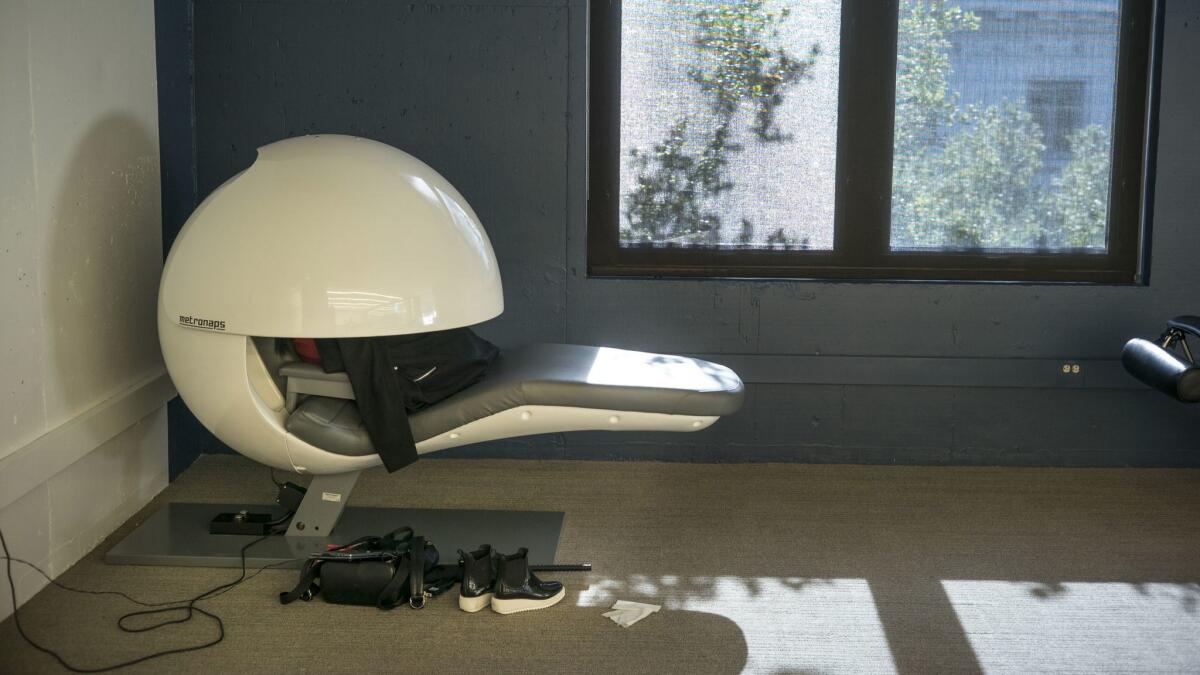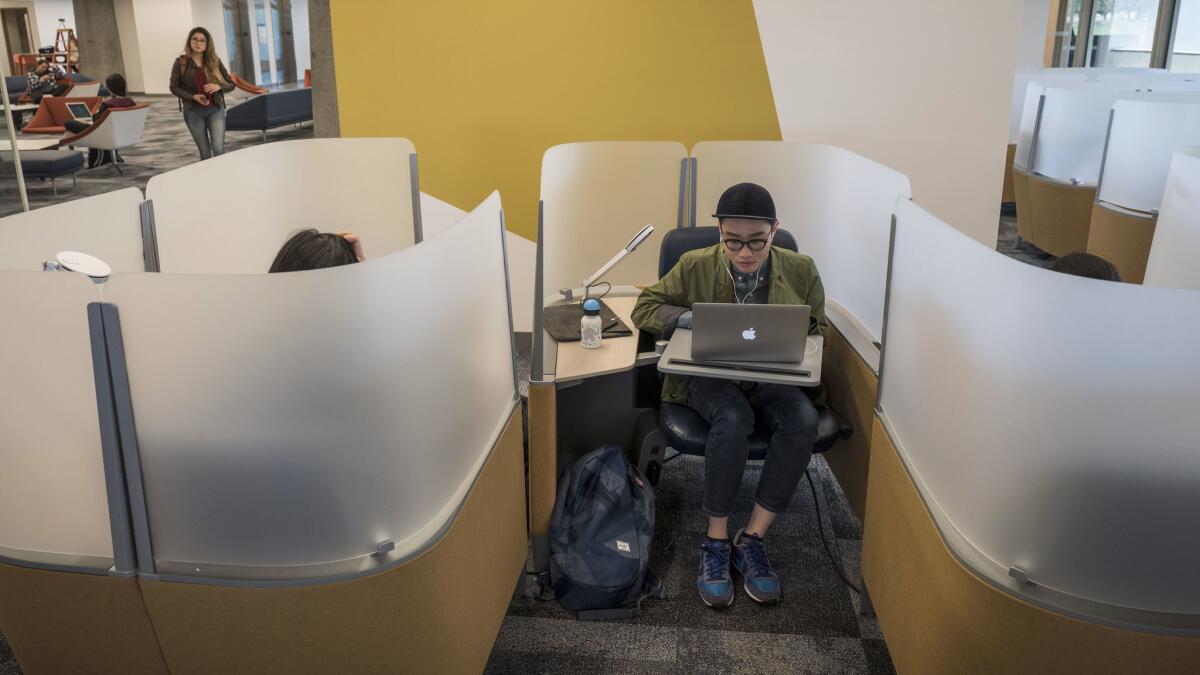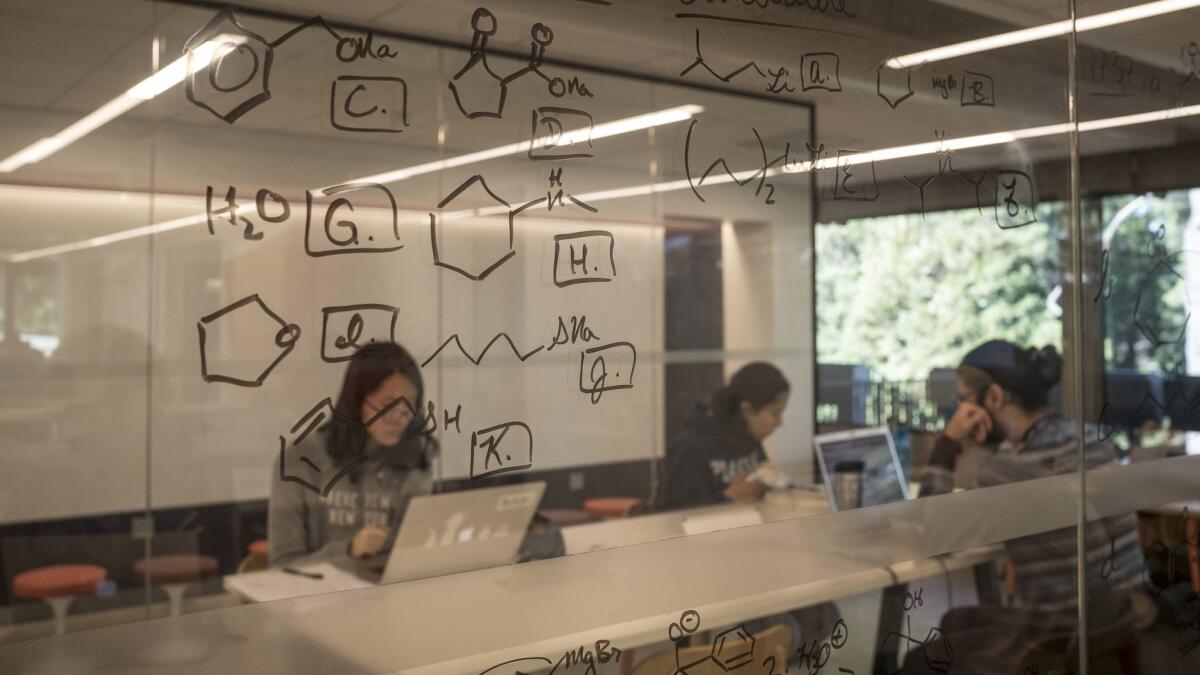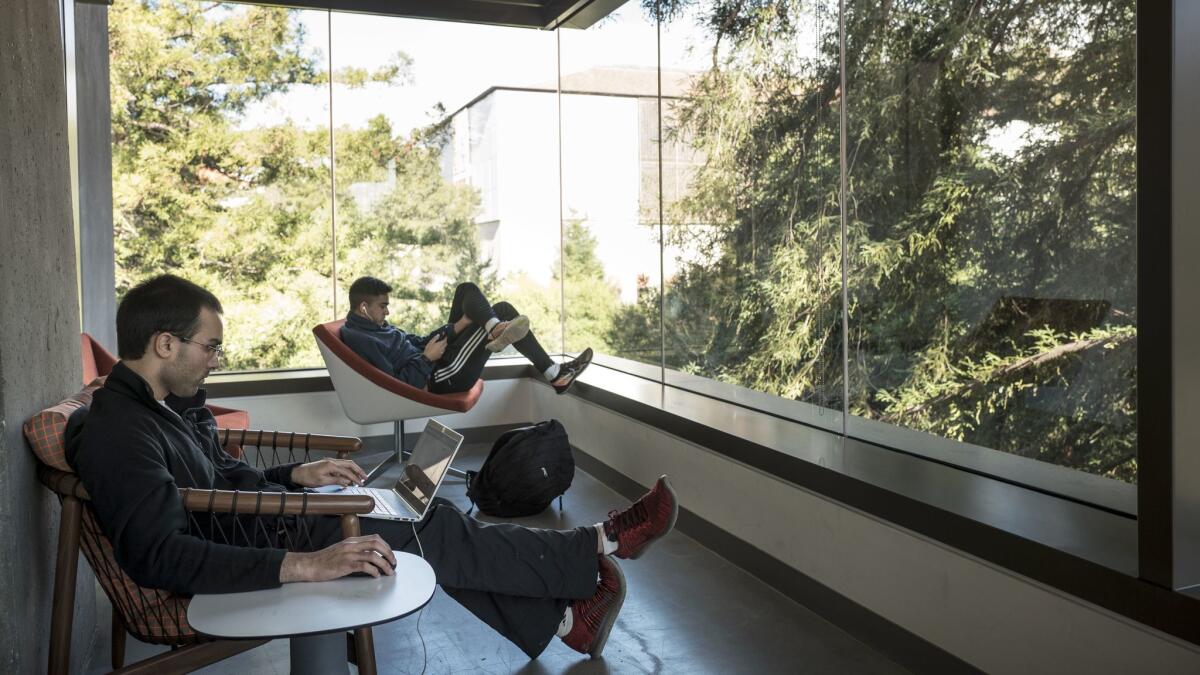Universities redesign libraries for the 21st century: fewer books, more space

University libraries are being redesigned for the digital age by getting rid of books. (April 19, 2017) (Sign up for our free video newsletter here http://bit.ly/2n6VKPR)
- Share via
Reporting from Berkeley — UC Berkeley’s newly remodeled undergraduate library is modern and sleek, with its top two floors featuring low-slung couches, a futuristic nap pod, and meeting spaces with glass walls made to be written on and colorful furniture meant to be moved.
The library has even dropped its rules against bringing in food and drinks on those floors. That’s because they no longer contain any books, which could be damaged or stained.
California’s oldest public university has removed 135,000 books from Moffitt Library, shipping most to other locations, to create more space for students to study, recharge and collaborate on group projects — a staple of college work today.

Libraries are 4,000 years old, but the digital revolution is dramatically changing their use on college campuses. From coast to coast, UC Berkeley to Harvard University, libraries are removing rows of steel shelving, stashing the books they held in other campus locations and discarding duplicates to make way for open study spaces. Their budgets are shifting away from print, to digital materials.
The changes have met resistance. But they suit many students just fine.
Ted Xiao, a graduate student in electrical engineering and computer science, loves the changes at Moffitt. He and five classmates recently used a meeting room to work on a PowerPoint presentation. As they brainstormed, they ate snickerdoodles, washed down with milk tea.
Moffitt used to be so “old and musty,” Xiao said, that he visited once and never returned. Now he comes often — and doesn’t miss the books. Everything he needs is online.
“I’ve never actually needed to use a physical book,” Xiao said. “I’ve never checked one out. I can’t honestly say I even know how.”

At UC Santa Cruz, however, the removal of 80,000 books from the Science and Engineering Library last summer sparked uproar -- among faculty. This winter, more than 60 science and math faculty members signed a letter to university librarian M. Elizabeth Cowell, complaining that they hadn’t been adequately consulted on which books could be discarded and which ones had to be saved.
Cowell wrote in reply that she had conferred with deans and administrators, posted updates on the library’s homepage, but received no “significant concern.” She said all of the books that were moved or destroyed — about 60% of the library’s collection — were used infrequently and could be accessed online or through UC interlibrary loans.
“Nothing has left the scholarly record,” said campus spokesman Scott Hernandez-Jason.
UC Santa Cruz increased enrollment by 730 students last fall. Removing all books from the library’s third floor, Hernandez-Jason said, allows for a classroom and “desperately needed study space.”
Still, the Academic Senate approved a resolution in November to say it “condemns the dramatic reduction of the print collection” and “deplores the destruction of books.”
Richard Montgomery, a UC Santa Cruz math professor, said online access or interlibrary loans are fine for those who know exactly what they need. What’s gone is the ability to browse for ideas.

“You walk into a space that used to be a library and it’s empty,” he said. “It’s horrible. It’s like death.”
Harvard University faculty succeeded in scaling back a plan to remove about 90% of books and print material from the Cabot Science Library. Curtis T. McMullen, a math professor, said he fought hard to keep many of the math books, which help him puzzle through research problems. They have a long shelf life, he said; think Euclidean geometry, which is more than 2,000 years old.
Thanks to such arguments, administrators agreed to keep 50,000 books within reach in the library basement.
But McMullen said he accepts that print books are on their way out.
“It’s the wave of the future,” he said of digital learning. “The idea of research in a library is becoming archaic, versus Googling on the Internet. Maybe they’re not accessing the best information with what comes up on Google, but people are used to finding things on the Internet.”
UCLA was a leader in library redesign, reconfiguring a floor in the Charles E. Young Research Library in 2011 to make room for open seating, group study rooms and collaboration pods equipped with LCD monitors for presentations. About 18,000 volumes — half the print reference collection — were moved elsewhere, but more than 2 million books remain on other floors.

At UC Berkeley’s Haas School of Business, students led a successful charge to get rid of books. They gained traction by invoking one of the school’s mantras: question the status quo.
Hilary Schiraldi, the business school librarian, said students kept asking her, “In the spirit of challenging the status quo, why is this library filled with dusty books no one looks at and I can’t get a study space?”
They had a point, she said. After all, she now spends 95% of the library budget on online materials. Meanwhile, printed archives of stock prices, annual reports and directories of corporate officers have become obsolete.
Suren Dias, a senior in anthropology who works in the business library, said many students also see e-books as more environmentally friendly.
“The collections lost their purpose,” Schiraldi said. “It was time to move to a digital library.”

The school decided in 2014 to move 70,000 books — nearly its entire print collection — into storage facilities. Students now have 12,000 more square feet for “collaborative tables,” comfy armchairs, movable whiteboards, even two exercise bikes.
UC Berkeley librarian Jeffrey MacKie-Mason said the campus still has one of the largest university book collections in the nation — 12 million circulating volumes held in two dozen libraries. The print materials include original Shakespeare folios, copies of John Wycliffe’s 14th-century Bible translations and the largest North American collection of ancient Egyptian papyrus fragments.
In fact, the continued importance of print materials in the digital age, he said, was the biggest takeaway from the Berkeley Library’s newly completed five-year strategic plan.
“Most of the world’s information is still in print,” he said, noting that online resources are widely available only in English and a few other languages. Berkeley, the world’s top public research university, collects materials in 200 languages.
“So moving toward the future is tricky,” MacKie-Mason said. “We need to do it and will be doing it quite aggressively, but we can’t destroy what we’re dependent on.”
On a recent day at Moffitt Library, where the $15-million renovation was unveiled last fall, Bijal Patel, a teaching assistant for a healthcare class, talked with seven students about medical internships over homemade pasta, lemonade and M&Ms. Her favorite features are the new food policy (“There’s no need to hide coffee in your backpack”) and the whiteboards and writable glass walls, which allow her to work out problems with classmates.
“Using paper is wasteful,” she said. “Here you can draw it out on the board, reason with classmates and hash it out in 20 minutes.”
The renovation plan, 10 years in the making, initially envisioned remodeling all five floors — but the 2008 recession forced Berkeley to scale it back to two as a “demo project in what students today need,” said Elizabeth Dupuis, the associate university librarian.
The five-story concrete library was built in the Brutalist architectural style, which was popular in the 1960s but came to be regarded as “unfriendly” by students, according to Aaron Howe-Cornelison of Gensler Architecture, the project’s design firm. The firm refashioned the top floors into a hip warehouse-style space, with larger windows, transparent walls and higher ceilings with exposed vent ducts.
The fourth floor, called “Buzz,” is the collaborative space, where students are free to chat, brainstorm and practice presentations. They can check out projectors, iPads, laptops, chargers and dry-erase markers.
The fifth floor, “Hush,” is a quieter space with wide tables and individual study carrels with their own lights and outlets. Three-dimensional geometric wall art is designed to absorb sound. A “wellness room” features reclining chairs and a nap pod with a top that flips down to create darkness and privacy.
Moffitt stays open around the clock Monday through Friday and during finals and midterms, and until 10 p.m. on weekends. It also has lockers for the growing number of students who live too far away to run home between classes, Dupuis said.
“In the end,” she said, “students feel comfortable and can work for very long hours.”
Berkeley being Berkeley, though, some students have panned the redesign.
Daniel Menegaz, a freshman, called Moffitt “the most ridiculed library on campus.” He said he liked the “fresh and clean look,” but finds it nearly impossible to nab a free seat. As for the open areas and meeting rooms, he thinks they’re a waste of space, and some tables are too low to use a laptop comfortably.
The absence of books doesn’t bother him. He either buys books so he can mark them up or reads them online.
“To me, libraries have just been study spaces,” he said.
ALSO
UCLA law school will use a unique $20-million gift to study Armenian genocide and other atrocities
How do squirrels think? This Berkeley lab is studying the revered campus rodent to find out
Average cost of attending a UC campus rose about 4% last year, regents told
More to Read
Sign up for Essential California
The most important California stories and recommendations in your inbox every morning.
You may occasionally receive promotional content from the Los Angeles Times.














